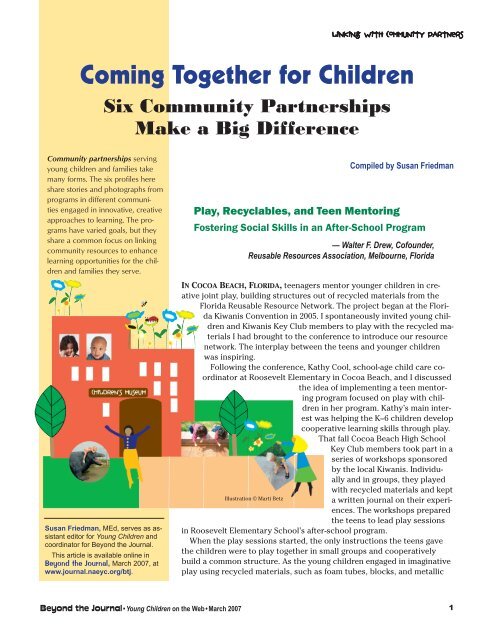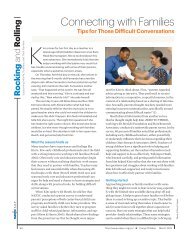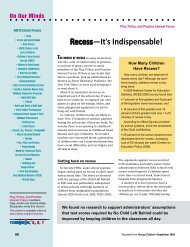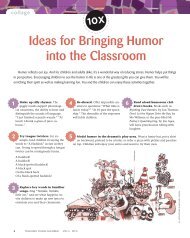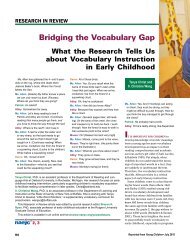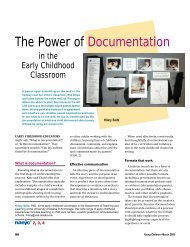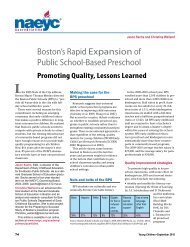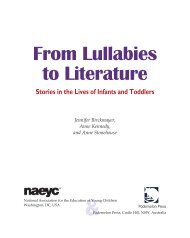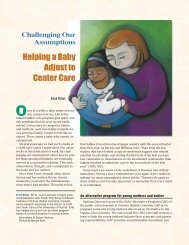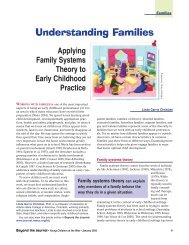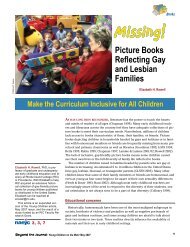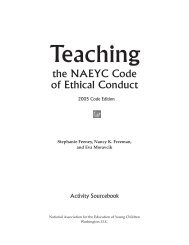Coming Together for Children: Six Community Partnerships Make
Coming Together for Children: Six Community Partnerships Make
Coming Together for Children: Six Community Partnerships Make
You also want an ePaper? Increase the reach of your titles
YUMPU automatically turns print PDFs into web optimized ePapers that Google loves.
Beyond the Journal • Young <strong>Children</strong> on the Web • March 2007<br />
linking with community partners<br />
<strong>Coming</strong> <strong>Together</strong> <strong>for</strong> <strong>Children</strong><br />
<strong>Six</strong> <strong>Community</strong> <strong>Partnerships</strong><br />
<strong>Make</strong> a Big Difference<br />
<strong>Community</strong> partnerships serving<br />
young children and families take<br />
many <strong>for</strong>ms. The six profiles here<br />
share stories and photographs from<br />
programs in different communities<br />
engaged in innovative, creative<br />
approaches to learning. The programs<br />
have varied goals, but they<br />
share a common focus on linking<br />
community resources to enhance<br />
learning opportunities <strong>for</strong> the children<br />
and families they serve.<br />
Susan Friedman, MEd, serves as assistant<br />
editor <strong>for</strong> Young <strong>Children</strong> and<br />
coordinator <strong>for</strong> Beyond the Journal.<br />
This article is available online in<br />
Beyond the Journal, March 2007, at<br />
www.journal.naeyc.org/btj.<br />
Play, Recyclables, and Teen Mentoring<br />
Compiled by Susan Friedman<br />
Fostering Social Skills in an After-School Program<br />
— Walter F. Drew, Cofounder,<br />
Reusable Resources Association, Melbourne, Florida<br />
In CoCoa BeaCh, FlorIda, teenagers mentor younger children in creative<br />
joint play, building structures out of recycled materials from the<br />
Florida Reusable Resource Network. The project began at the Florida<br />
Kiwanis Convention in 2005. I spontaneously invited young children<br />
and Kiwanis Key Club members to play with the recycled materials<br />
I had brought to the conference to introduce our resource<br />
network. The interplay between the teens and younger children<br />
was inspiring.<br />
Following the conference, Kathy Cool, school-age child care coordinator<br />
at Roosevelt Elementary in Cocoa Beach, and I discussed<br />
the idea of implementing a teen mentoring<br />
program focused on play with children<br />
in her program. Kathy’s main interest<br />
was helping the K–6 children develop<br />
cooperative learning skills through play.<br />
That fall Cocoa Beach High School<br />
Key Club members took part in a<br />
series of workshops sponsored<br />
by the local Kiwanis. Individually<br />
and in groups, they played<br />
with recycled materials and kept<br />
Illustration © Marti Betz<br />
a written journal on their experiences.<br />
The workshops prepared<br />
the teens to lead play sessions<br />
in Roosevelt Elementary School’s after-school program.<br />
When the play sessions started, the only instructions the teens gave<br />
the children were to play together in small groups and cooperatively<br />
build a common structure. As the young children engaged in imaginative<br />
play using recycled materials, such as foam tubes, blocks, and metallic
cloth, they contributed their individual<br />
ideas and together negotiated<br />
a vision <strong>for</strong> their project. They<br />
took turns placing items on the<br />
structure and cooperated to solve<br />
structural problems.<br />
Kathy views the play sessions as<br />
a great success. “I see play as a basic<br />
learning skill,” she comments.<br />
“The children pay attention and<br />
learn how much more they can do<br />
when they cooperate and work together.<br />
The parents see the joy and<br />
excitement their children express<br />
over what they have accomplished,<br />
and that helps parents value play<br />
as an important instructional activity.”<br />
One high school student, having<br />
observed the interplay between<br />
children’s imaginations and cooperative<br />
play, noted several things:<br />
“The children seemed very intent<br />
within their own individual imaginations<br />
even though in groups they<br />
were able to construct together. It’s<br />
really amaz-<br />
ing how they<br />
can understand<br />
each<br />
other’s<br />
visions.<br />
<strong>Together</strong><br />
they built a<br />
single structure,<br />
but in<br />
each of their<br />
minds it was<br />
their own.”<br />
<strong>Together</strong> they<br />
built a single<br />
structure, but<br />
in each of their<br />
minds it was<br />
their own.<br />
All of the adults involved with<br />
the project feel so strongly about<br />
its success that they have introduced<br />
the idea in other high<br />
schools and child care settings. The project deeply impressed Kiwanis International<br />
Young <strong>Children</strong> Priority One coordinator Jane Judy-Miller, and she<br />
has proposed Kiwanis sponsorship of a similar project worldwide.<br />
For more in<strong>for</strong>mation about this program, visit www.reusableresources.org.<br />
Some in<strong>for</strong>mation in this profile is drawn from the booklet A Successful Key<br />
Club Mentoring Program: Mentored Play Sessions in a K–6 After-School Program,<br />
Implementing the Mandate: “Young <strong>Children</strong> Priority One,” by Hugh<br />
Halsey and Walter F. Drew (Melbourne, FL: Reusable Resources Association,<br />
2006).<br />
Beyond the Journal • Young <strong>Children</strong> on the Web • March 2007<br />
Courtesy Walter F. Drew<br />
linking with community partners<br />
As the young children<br />
engaged in imaginative<br />
play, they contributed<br />
their individual<br />
ideas and together<br />
negotiated a vision <strong>for</strong><br />
their project.<br />
Courtesy Walter F. Drew
Artists in the <strong>Community</strong><br />
Bookmaking with Elementary-age <strong>Children</strong><br />
— Janet Petitpas, Deputy Director,<br />
Bay Area Discovery Museum, Sausalito, Cali<strong>for</strong>nia<br />
The Bay area dIsCovery MuseuM in Sausalito, Cali<strong>for</strong>nia, connects children<br />
with scientists, artists, and other professionals through a variety of<br />
museum and community programs. One such project, My Artist Book,<br />
was developed with the Canal <strong>Community</strong> Alliance After-School Program<br />
in San Rafael. This project offered children in the after-school<br />
program a series of workshops led<br />
by the museum’s creative arts spe-<br />
cialist and its photographer, along<br />
with a professional book artist.<br />
They worked with the children to<br />
help them create personalized stories<br />
reflecting their experiences in<br />
the community. One of the project<br />
goals was to empower children as<br />
active participants in their community<br />
by helping them document and<br />
celebrate its history.<br />
Over a series of weeks the photographer guided the children<br />
in learning photography skills, including how to compose<br />
a picture. The creative arts specialist engaged the children<br />
in thinking about the components of storytelling and<br />
considering carefully what they wanted their story to convey<br />
about themselves and their community through their books.<br />
Later, the book artist helped the children select photos that<br />
best told their stories, decide on story text placement, and<br />
construct their books.<br />
The culminating event <strong>for</strong> the My Artist Book project took<br />
place when the children came to the museum with their families<br />
to show them the display of the books they created. In the<br />
roles of guest speakers, the children described and discussed<br />
the bookmaking process with the museum’s general audience.<br />
The children and their families were proud of their book creations and<br />
excited to see that museum visitors found the exhibit interesting.<br />
<strong>Community</strong> collaboration can be challenging. At the museum we work<br />
with groups in advance to establish project goals and to ensure that together<br />
we can create a program that serves the community’s interest.<br />
One of the most important things we have learned is the importance of<br />
sharing with a partner: share the challenges, share the leadership, share<br />
the praise.<br />
For more in<strong>for</strong>mation about the museum’s community programs, contact<br />
the author by e-mail at jpetitpas@badm.org.<br />
Beyond the Journal • Young <strong>Children</strong> on the Web • March 2007<br />
One of the most important things<br />
we have learned is the importance<br />
of sharing with a partner:<br />
share the challenges, share the<br />
leadership, share the praise.<br />
linking with community partners<br />
Courtesy of Bay Area Discovery Museum
Courtesy of Alex Fayvil, LAVC Valley Star Press<br />
Learning about Babies<br />
Parent and Baby Sessions at a <strong>Community</strong> College<br />
— Marni Roosevelt, Director of Special Projects,<br />
Child Development Department, Los Angeles Valley College,<br />
Valley Glen, Cali<strong>for</strong>nia<br />
los angeles valley College in Valley Glen, Cali<strong>for</strong>nia, has a unique oncampus<br />
program that provides child development students with handson<br />
experiences in infant and toddler care while also meeting the needs of<br />
student parents in the larger campus population. For several years, child<br />
development instructors had considered ways to help student parents<br />
with babies, who often sought guidance on a variety of parenting concerns.<br />
The college does not provide a center <strong>for</strong> infant and toddler care,<br />
and we knew that child development students needed experiences with<br />
babies. Thus the child development department created Parent and Baby<br />
Sessions to meet these dual needs.<br />
During the Parent and Baby Sessions, student parents and their babies<br />
participate in play sessions. Child development faculty talk with the<br />
moms and dads about parenting and child development, while the program’s<br />
student interns, under the guidance of a child development instructor,<br />
interact with and care <strong>for</strong> the babies. For many child development<br />
interns, this is their first experience with infants and<br />
toddlers in a space designed specifically <strong>for</strong> their learning<br />
and care. In this carefully thought-out environment, a child<br />
development instructor models best practices.<br />
The setting is a college classroom—trans<strong>for</strong>med. The instructor<br />
and interns set up the room with equipment <strong>for</strong><br />
play and learning, including floor mats, sensory tables,<br />
scarves, and laundry baskets as well as other low-cost, developmentally<br />
appropriate materials. Using familiar, common<br />
items helps parents and interns see that they can<br />
Beyond the Journal • Young <strong>Children</strong> on the Web • March 2007<br />
linking with community partners<br />
stimulate children’s development<br />
with many kinds of inexpensive,<br />
everyday resources.<br />
Our successes are gratifying.<br />
The sessions are full and the program<br />
has a waiting list. A high<br />
number of requests <strong>for</strong> participation<br />
have come from parents in the<br />
community. We are expanding the<br />
program to offer more weekly sessions.<br />
More than 90 percent of the<br />
interns completing the program<br />
have been offered employment in<br />
the early care and education field.<br />
This low-cost, high-quality program<br />
is easily replicable. My recommendation<br />
is to start small. If<br />
we had included everything we<br />
wanted in the program from the<br />
beginning, we might never have<br />
gotten it up and running. (Search<br />
within your immediate community<br />
to build support and identify funding<br />
sources.)<br />
Now that Parent and Baby Sessions<br />
has strong support and interest,<br />
we feel that we can expand.<br />
The college has renovated a dedicated<br />
space <strong>for</strong> our program! The<br />
program’s initial grant was broadly<br />
focused on building an infant/toddler<br />
care work<strong>for</strong>ce. An additional<br />
two years’ funding through a Cali<strong>for</strong>nia<br />
State Chancellor’s Economic<br />
and Work<strong>for</strong>ce Development<br />
Grant will help us build a work<strong>for</strong>ce<br />
of teachers trained in caring<br />
<strong>for</strong> babies and toddlers with special<br />
needs.<br />
For more in<strong>for</strong>mation, visit the Web<br />
site www.lavc.edu or contact the author<br />
by e-mail at roosevm@lavc.edu.<br />
Using familiar, common items helps<br />
parents and interns see that they can<br />
stimulate children’s development with<br />
many kinds of inexpensive, everyday<br />
resources.
Tips <strong>for</strong> Starting a Successful<br />
<strong>Community</strong> Partnership<br />
— Jillian Ritter, Early Childhood Specialist,<br />
EightCAP Inc., Early Head Start,<br />
Mt. Pleasant, Michigan<br />
These tips <strong>for</strong> partnering can be used by individuals,<br />
large agencies, specialists, or administrators.<br />
Collaboration makes everyone’s<br />
job a little easier and helps to ensure that children<br />
and families receive quality services.<br />
● Identify groups in your community with goals<br />
similar to those of your program. They may be<br />
interested in <strong>for</strong>ming a partnership.<br />
● Involve all programs in the planning from<br />
the beginning. <strong>Make</strong> sure representatives of<br />
all groups are involved and committed to the<br />
collaboration.<br />
● Establish a shared vision and definition of<br />
collaboration. Create a Collaboration Agreement<br />
to detail exactly what each program’s<br />
responsibilities are and what outcomes are<br />
expected.<br />
● Remember, you do not need to spend money<br />
to start collaborating! In fact, it is possible to<br />
save money as a result of collaboration.<br />
● Communicate clearly and frequently. <strong>Make</strong><br />
sure each program understands the other’s<br />
rules, standards, and guidelines. Ask<br />
questions.<br />
● Schedule regular meetings at times that<br />
most of the people involved are available.<br />
Serve refreshments!<br />
● Be patient. It takes time to see benefits of<br />
change and collaboration. The benefits are<br />
worth the ef<strong>for</strong>t!<br />
Not sure where to begin? Ideas <strong>for</strong> collaboration<br />
in your community are available from the<br />
following organizations: child welfare services,<br />
Early Head Start (EHS) or Head Start, local<br />
universities or colleges, public libraries, child<br />
care centers or preschools, and public schools.<br />
EightCAP Inc., has <strong>for</strong>mally partnered with<br />
the local Child Welfare Services (CWS) <strong>for</strong><br />
nearly four years. EHS and CWS work together<br />
to coordinate services to meet both<br />
the family’s and the child’s needs. For more<br />
in<strong>for</strong>mation, contact the author by e-mail at<br />
jillianr@8cap.org.<br />
Beyond the Journal • Young <strong>Children</strong> on the Web • March 2007<br />
linking with community partners<br />
Learning Readiness<br />
Parents, <strong>Children</strong>, and the Culture of Kindergarten<br />
— Maureen Mangan, Director of Communication and<br />
Public Relations, Long Island <strong>Children</strong>’s Museum, New York<br />
FIve sChool dIsTrICTs surrounding the Long Island <strong>Children</strong>’s<br />
Museum (LICM) have a higher percentage of children with limited<br />
English proficiency than the New York state average. To address<br />
the needs of these local families,<br />
LICM created the Juntos al<br />
Kinder [<strong>Together</strong> to Kindergarten]<br />
readiness program, which acclimates<br />
the whole family to the culture of the<br />
kindergarten classroom.<br />
Juntos al Kinder was inspired by<br />
the combined experiences of the museum<br />
staff. The executive director<br />
saw the impact and effectiveness<br />
of the Boston <strong>Children</strong>’s<br />
Museum’s kindergarten readiness<br />
program. The early childhood<br />
manager had previously<br />
been a kindergarten teacher<br />
in a nearby school district and<br />
was concerned about the academic<br />
delays children with limited<br />
English proficiency face<br />
as they enter the school system.<br />
The education director<br />
grew up in an immigrant family<br />
and knew the value of addressing<br />
cultural nuances as they relate<br />
to parental participation in<br />
schools.<br />
The program evolved<br />
through collaboration between<br />
staff members and conversations<br />
with community agencies<br />
and school districts on Long<br />
Island. The museum involved<br />
representatives from these<br />
two important groups early in the process as it mapped out<br />
its plans and the program content. We established three main<br />
goals <strong>for</strong> Juntos al Kinder:<br />
1. Ease the transition from home to kindergarten <strong>for</strong> preschool<br />
children with limited English proficiency<br />
2. Help the parents of children with limited English proficiency<br />
play a key role in their child’s education<br />
Courtesy of Long Island <strong>Children</strong>’s Museum<br />
The readiness program<br />
acclimates the<br />
whole family to the<br />
culture of the kindergarten<br />
classroom.
3. Encourage families to use the resources of the museum <strong>for</strong> their children’s<br />
lifelong learning.<br />
The program’s four educational components include offerings <strong>for</strong> children<br />
as well as parents:<br />
• Summer classes <strong>for</strong> preschoolers, conducted primarily in English, provide<br />
intensive language learning and give the children a base of words<br />
they will encounter in kindergarten. <strong>Children</strong> also become familiar with<br />
some of the routines and expectations in a kindergarten classroom.<br />
• Summer workshops <strong>for</strong> parents help them learn to navigate the school<br />
system, effectively communicate with teachers and school administrators,<br />
and also understand cultural nuances associated with the education<br />
system.<br />
• <strong>Community</strong> nights throughout the school year provide workshops <strong>for</strong><br />
parents, museum explorations <strong>for</strong> their children, and an opportunity <strong>for</strong><br />
families to socialize with each other.<br />
• Year-round services include a free museum family membership and<br />
parent workshops throughout the year.<br />
Parents and school staff agree that the program is a success. One<br />
mother expressed this feeling: “I wish we’d had this program when my<br />
son went to kindergarten.” School principal Brenda Williams Jackson,<br />
Northern Parkway Elementary School in Uniondale, commented, “I believe<br />
our first day of school was especially successful. The parents who<br />
attended the program felt com<strong>for</strong>table escorting their children to class<br />
because they were less anxious.”<br />
The parent education component is essential to the success of this<br />
program. We encourage any community undertaking a similar program to<br />
be sure to build this in as a component of kindergarten readiness.<br />
For more in<strong>for</strong>mation, contact the author by e-mail at mangan@licm.org.<br />
Beyond the Journal • Young <strong>Children</strong> on the Web • March 2007<br />
linking with community partners<br />
Courtesy of Long Island <strong>Children</strong>’s Museum
Resource and Referral<br />
Responding to Family and Caregiver Needs in the <strong>Community</strong><br />
resourCe and reFerral agenCIes are<br />
community-focused organizations that<br />
provide referral services to families<br />
seeking child care; train and recruit<br />
child care providers; work to increase<br />
the supply of child care; and provide<br />
in<strong>for</strong>mation about child development<br />
to families, caregivers, and the community.<br />
Regional resource and referral<br />
agencies provide these services at the<br />
local level to support each community’s<br />
specific needs.<br />
The Sacramento Quality Child Care<br />
Collaborative (QCCC), administered<br />
by Child Action Inc., has many partners<br />
serving the Sacramento area. With<br />
communities ever changing, service<br />
agencies must adapt to meet the current<br />
needs of children and families. Although<br />
the core service of resource and referral agencies is referring families<br />
to available child care, it is important to include related services and opportunities<br />
to help meet the needs of individual families.<br />
Through focus groups and parent and provider surveys, we identified the<br />
Sacramento area’s top needs and then developed a plan of action to address<br />
each one:<br />
1. Not enough child care services are available to meet the growing demand<br />
<strong>for</strong> care.<br />
Solution: Use state and county funds to recruit and train new family<br />
child care providers and to support groups wishing to open and expand<br />
child care centers.<br />
2. Parents of children with special needs can’t find adequate child care.<br />
Child care programs may be ill-equipped or providers may feel unprepared<br />
to care <strong>for</strong> children with special needs.<br />
Solutions: Assign a resource and referral specialist to talk to families<br />
about their situations; then contact child care providers who can meet<br />
the families’ needs. In Sacramento we offer on-site support <strong>for</strong> child<br />
care providers serving children with special needs, including behavior<br />
modeling, strategies <strong>for</strong> working with children and parents, demonstrated<br />
use of adaptive equipment, and more.<br />
3. Child care providers need access to training and resources on caring<br />
<strong>for</strong> children with disabilities, infants and toddlers, and health and mental<br />
health best practices.<br />
Solution: Offer providers single workshops as well as intensive, targeted<br />
60-hour training and technical assistance programs, such as the Program<br />
<strong>for</strong> Infant/Toddler Care.<br />
Beyond the Journal • Young <strong>Children</strong> on the Web • March 2007<br />
— Leslie Simmons, Resource and Referral Manager,<br />
Child Action Inc., Sacramento, Cali<strong>for</strong>nia<br />
linking with community partners<br />
With communities<br />
ever<br />
changing, service<br />
agencies<br />
must adapt to<br />
meet the current<br />
needs of<br />
children and<br />
families.<br />
4. Maintaining staff stability and<br />
providing effective leadership <strong>for</strong><br />
their programs are big challenges<br />
<strong>for</strong> directors.<br />
Solution: Offer directors in<strong>for</strong>mation<br />
about programs that<br />
give financial stipends to staff<br />
who earn a certain number of<br />
college unit credits each year;<br />
provide special training opportunities<br />
<strong>for</strong> directors and/<br />
or family child care providers<br />
to support them in meeting<br />
the administrative challenges<br />
of running a quality child care<br />
program.<br />
Building collaborative services is<br />
difficult work, requiring flexibility<br />
of thought and generosity of spirit.<br />
Throughout our work we have<br />
learned to pay attention to the<br />
needs of all—children, their families,<br />
and child care providers.<br />
For more in<strong>for</strong>mation, visit the<br />
Web site www.childaction.org.<br />
© Paula Jorde Bloom
The Museum Is Their Classroom<br />
Preschoolers Play with the Real Stuff<br />
— Carol Barone-Martin, Senior Program Officer, Early Childhood<br />
Education, Pittsburgh Public Schools, Pennsylvania<br />
In Fall 2005, the <strong>Children</strong>’s Museum<br />
of Pittsburgh became school<br />
to two Pittsburgh Public Schools’<br />
early childhood classrooms—with<br />
funding from Head Start and the<br />
Commonwealth of Pennsylvania Accountability<br />
Block Grant, and other<br />
sources. This unique partnership<br />
grew out of a conversation I had<br />
with the executive director of the<br />
<strong>Children</strong>’s Museum of Pittsburgh,<br />
Jane Werner. We knew each other<br />
through participation in our local Affiliate<br />
(PAEYC) council, and we also<br />
worked together to promote Week of<br />
the Young Child.<br />
At the time, the <strong>Children</strong>’s Museum<br />
was undergoing renovation and<br />
expansion, and the Pittsburgh Public<br />
Schools system was looking <strong>for</strong><br />
Courtesy of Pittsburgh Public Schools Early Childhood Education Programs<br />
Beyond the Journal • Young <strong>Children</strong> on the Web • March 2007<br />
additional space <strong>for</strong> early childhood<br />
education classrooms. Why not, we<br />
thought, create space in the museum<br />
<strong>for</strong> a few extra early childhood<br />
classrooms? Once the idea of having<br />
classrooms in the museum developed,<br />
the Pittsburgh Board of Public<br />
Education, the <strong>Children</strong>’s Museum<br />
Board of Directors, and the museum’s<br />
funders embraced the concept.<br />
Even though the preschoolers<br />
have their own classrooms, they use<br />
the entire museum as their educational<br />
environment. Based on the<br />
museum’s philosophy—Play with<br />
Real Stuff—the children explore the<br />
museum’s hands-on activities and<br />
exhibits throughout the day. They<br />
paint, draw, and create wonderful<br />
art projects in the museum’s large<br />
The children<br />
explore the<br />
museum’s<br />
hands-on<br />
activities<br />
and exhibits<br />
throughout<br />
the day.<br />
linking with community partners<br />
studio. They make up stories and<br />
act them out in the museum’s theater,<br />
using the props that are available<br />
there. In the water play area of<br />
the museum, the children explore<br />
science concepts as they play.<br />
The museum exhibits and activities<br />
rein<strong>for</strong>ce what the children are<br />
learning in the classroom through<br />
the curriculum. For example, a museum<br />
child development specialist<br />
visits the classrooms weekly to read<br />
to the children. Museum staff and<br />
classroom teachers make sure that<br />
the children’s work in the studio<br />
aligns with these literacy sessions.<br />
Excited about the integrated<br />
learning the children experience in<br />
the museum, we recently hired an<br />
arts coordinator through funding<br />
from the Pittsburgh Foundation. The<br />
arts coordinator works with artists<br />
and early childhood professionals in<br />
developing an integrated arts curriculum<br />
in which the children learn literacy,<br />
math, social studies, science,<br />
and social skills while participating<br />
in various arts projects. This integrated<br />
arts curriculum will be piloted<br />
at the <strong>Children</strong>’s Museum’s classrooms<br />
and in classrooms at two<br />
additional Pittsburgh elementary<br />
schools in the near future.<br />
We have benefited great-<br />
ly from engaging in this collaboration,<br />
particularly<br />
learning that it is important<br />
to talk about regulations<br />
and philosophy be<strong>for</strong>e beginning<br />
any partnership.<br />
The museum staff have also<br />
learned how to improve materials<br />
and exhibits from<br />
their ongoing observations<br />
of the same group of children<br />
using them every day.<br />
For more in<strong>for</strong>mation<br />
about this project, contact<br />
the Early Childhood Education<br />
Department, Pittsburgh Public<br />
Schools, at 412-325-4291.<br />
Copyright © 2007 by the National Association <strong>for</strong> the Education<br />
of Young <strong>Children</strong>. See Permissions and Reprints online<br />
at www.journal.naeyc.org/about/permissions.asp.


